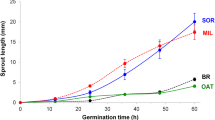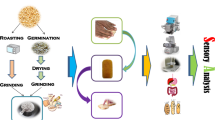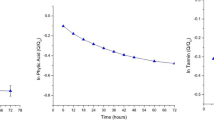Abstract
The combined effects of grain germination and of subsequent fermentation on the physicochemical properties of sorghum flour were investigated by studying the structural changes occurring in the starch and protein fractions and by assessing their effects on physical properties of the resulting materials most relevant to end use. The sequential treatments were more effective than either individual treatment in the modification of starch-related properties, whereas modification of the protein components only occurs in the fermentation step, almost regardless of a previous germination step. The resulting profile of physicochemical traits offers several hints as for the suitability of flour from treated sorghum as an ingredient for various types of gluten-free food products, and provides a basis for expanding the use of processed sorghum in applications other than traditional African foods.





Similar content being viewed by others
References
Abbey BW, Ibeh GO (1998) Functional properties of raw processed cowpea (Vigna unguiculata) flour. J Food Sci 53:1775–1777
Aviara NA, Igbeka JC, Nwokocha LM (2010) Physicochemical properties of sorghum (Sorghum bicolor L. Moench) starch as affected by drying temperature. Agric Eng Int CIGR J 12:85–94
Baker LA, Rayas-Duarte P (1998) Freeze-thaw stability of amaranth starch and the effect of salt and sugars. Cereal Chem 75:301–307
Becker R, Hanners GC (1991) Carbohydrate composition of cereal grains. In: Lorenz KJ, Kulp K (eds) Handbook of cereal science and technology. Marcel Dekker, New York, pp 482–483
Bradford MM (1976) A rapid and sensitive method for the quantitation of microgram quantities of protein utilizing the principle of protein dye-binding. Anal Biochem 72:248–254
Claver IP, Zhang H, Li Q, Zhu K, Zhou H (2010) Impact of the soak and the malt on the physicochemical properties of the sorghum starches. Int J Mol Sci 11:3002–3015
Craig SAS, Maningat CC, Seib PA, Hoseney RC (1989) Starch paste clarity. Cereal Chem 66(3):173–182
de Morais Cardoso L, Pinheiro SS, Martino HS, Pinheiro-Sant’Ana HM (2017) Sorghum (Sorghum bicolor L.): nutrients, bioactive compounds, and potential impact on human health. Crit Rev Food Sci Nutr 57(2):372–390
Dhankher N, Chauhan BM (1987) Technical note. Preparation, acceptability and B vitamin content of Rabadi—fermented pearl millet food. Int J Food Sci Technol 22:173–176
El Tinay AH, Abdel Gadir AM, Ei Hidai M (1979) Sorghum fermented Kisra bread. 1. Nutritive value of Kisra. J Sci Food Agric 30:859–863
Elkhalifa AEO, Bernhardt R (2013) Some physicochemical properties of flour from germinated sorghum grain. J Food Sci Technol 50:186–190
Elkhalifa AEO, Schiffler B, Bernhardt R (2004) Selected physicochemical properties of starch isolated from fermented sorghum flour. Starch/Stärke 56:582–585
Elkhalifa AEO, Bernhardt R, Bonomi F, Iametti S, Pagani MA, Zardi M (2006a) Fermentation modifies protein/protein and protein/starch interactions in sorghum dough. Eur Food Res Technol 222:559–564
Elkhalifa AEO, Schiffler B, Bernhardt R (2006b) Some physicochemical properties of fermented sorghum flour. J Food Sci Technol 43:26–27
Ellman GL (1959) Tissue sulfhydryl groups. Arch Biochem Biophys 82:70–77
Gernah DI, Ariahu CC, Ingbian EK (2011) Effects of malting and lactic fermentation on some chemical and functional properties of maize (Zea mays). Am J Food Technol 6:404–412
Huang PV, Maeda T, Miskelly D, Tsumor R, Morita N (2008) Physicochemical characteristics and fine structure of high-amylose wheat starches isolated from Australian wheat cultivars. Carbohydr Polym 71:656–663
Kaur M, Singh N (2005) Studies on functional, thermal and pasting properties of flours from different chickpea (Cicer arietinum L.) cultivars. Food Chem 91:403–411
Kulkarni KD, Kulkarni DN, Ingle UM (1991) Sorghum malt-based weaning formulations: preparation, functional properties, and nutritive value. Food Nutr Bull 13:322–327
Lee YE, Osman EM (1991) Correlation of morphological changes of rice starch granules with rheological properties during heating in excess water. J Korean Chem Soc 34:379–385
Loos PJ, Hood LF, Graham HD (1981) Isolation and characterization of starch from breadfruit. Cereal Chem 58:282–286
Marengo M, Bonomi F, Marti A, Pagani MA, Elkhalifa AEO, Iametti S (2015) Molecular features of fermented and sprouted sorghum flours relate to their suitability as components of enriched gluten-free pasta. LWT Food Sci Technol 63:511–518
Marti A, Marengo M, Bonomi F, Casiraghi MC, Franzetti L, Pagani MA, Iametti S (2017) Molecular features of fermented teff flour relate to its suitability for the production of enriched gluten-free bread. LWT Food Sci Technol 78:296–302
Matalanis AM, Campanella OH, Hamaker BR (2009) Storage retrogradation behavior of sorghum, maize and rice starch pastes related to amylopectin fine structure. J Cereal Sci 50:74–81
Mora-Escobedo R, Lopez OP, Lopez GFG (1991) Effect of germination on the rheological and functional properties of amaranth seeds. LWT Food Sci Technol 24:241–244
Phattanakulkaewmorie N, Paseephol T, Moongngarm A (2011) Chemical compositions and physicochemical properties of malted sorghum flour and characteristics of gluten free bread. World Acad Sci Eng Technol 5:9–27
Rasane P, Jha A, Kumar A, Sharma N (2015) Reduction in phytic acid content and enhancement of antioxidant properties of nutricereals by processing for developing a fermented baby food. J Food Sci Techn 52(6):3219–3234
Renzetti S, Dal Bello F, Arendt EK (2008) Microstructure, fundamental rheology and baking characteristics of batters and breads from different gluten-free flours treated with a microbial transglutaminase. J Cereal Sci 48:33–45
Ross RP, Morgan S, Hill C (2002) Preservation and fermentation: past, present and future. Int J Food Microbiol 79:3–16
Schober TJ, Messerschmidt M, Bean SR, Park SH, Arendt EK (2005) Gluten-free bread from sorghum: quality differences among hybrids. Cereal Chem 82:394–404
Schober TJ, Bean SR, Boyle DL (2007) Gluten-free sorghum bread improved by sourdough fermentation: biochemical, rheological, and microstructural background. J Agric Food Chem 55:5137–5146
Sripriya G, Antony U, Chandra TS (1997) Changes in carbohydrate, free amino acids, organic acids, phytate and HCl extractability of minerals during germination and fermentation of finger millet (Eleusine coracana). Food Chem 58:345–350
Takeda C, Takeda Y, Hizukuri S (1983) Physicochemical properties of lily starch. Cereal Chem 60:212–216
Yu S, Ma Y, Menager L, Sun D (2012) Physicochemical properties of starch and flour from different rice cultivars. Food Bioproc Technol 5:626–637
Zheng GH, Sosulski FW (1998) Determination of water separation from cooked starch and flour pastes after refrigeration and freeze-thaw. J Food Sci 63:134–139
Zhu F (2014) Structure, physicochemical properties, modifications, and uses of sorghum starch. Compr Rev Food Sci Food Saf 13:597–610
Acknowledgements
This work was supported in part by the “PROTEUS” Project (Bando Linea R&S per Aggregazione, Regione Lombardia, Italy). Abd Elmoneim O. Elkhalifa is the grateful recipient of a Fellowship from the Alexander von Humboldt Foundation.
Author information
Authors and Affiliations
Corresponding author
Rights and permissions
About this article
Cite this article
Elkhalifa, A.E.O., Bernhardt, R., Cardone, G. et al. Physicochemical properties of sorghum flour are selectively modified by combined germination-fermentation. J Food Sci Technol 54, 3307–3313 (2017). https://doi.org/10.1007/s13197-017-2781-7
Revised:
Accepted:
Published:
Issue Date:
DOI: https://doi.org/10.1007/s13197-017-2781-7




